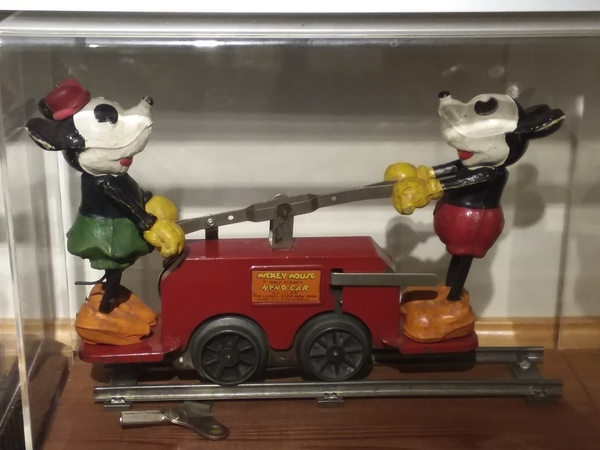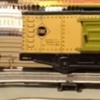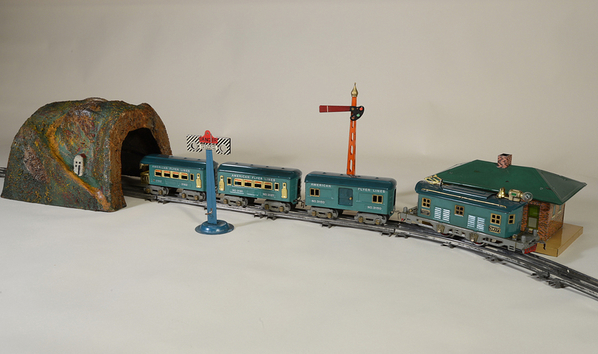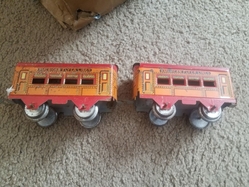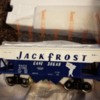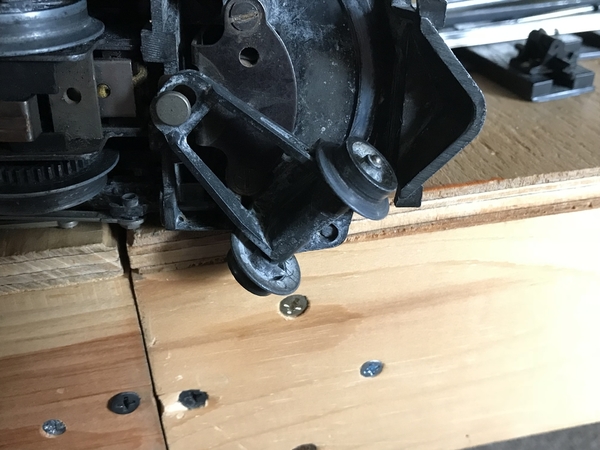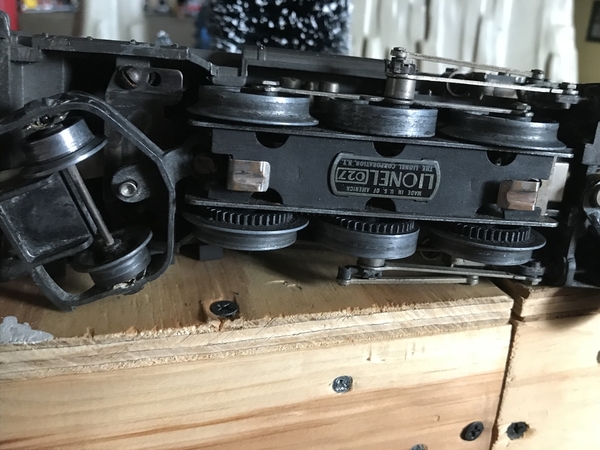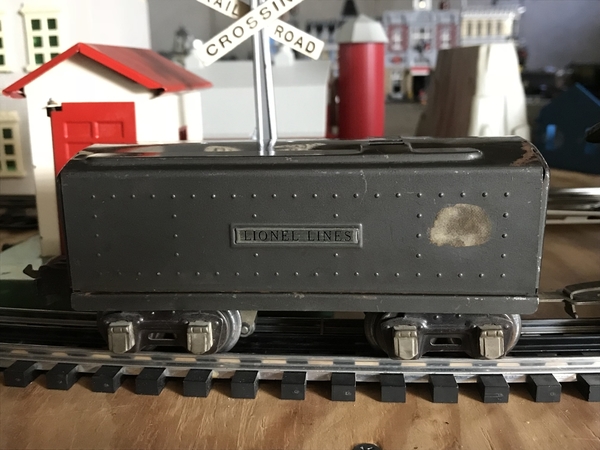This week to start off I relocated my monorail to the bottom level to bring back my top level O-36 which I originally removed to make room for the monorail set. The O-36 loop is perfect for running smaller trains. Let’s see your tinplate! ![]()



Replies sorted oldest to newest
Here's a throwback to a simpler time: A little freight set from Winner Lines and the Mickey Mouse and Donald Duck handcars.
Attachments
Great pic so far guys
Joe Gozzo
American Flyer Set #1328 - The New Bluebird - 1930
The catalog illustration of the set is a very close approximation to what was offered
1930 Catalog Illustration
However there are some differences between the catalog illustration, the actual set contents, and the markings on the boxes in the set.
The Complete Set
To begin with The catalog point of view is impossible – the artist took some license with respect to the size of the #96 station. If you put the camera at a level to try to get the catalog perspective you cannot see much of the station at all.
Second, the station illustration in the catalog and the station provided do not agree with respect to appearances. This is because the stations were assembled from 4 separate stampings – front, back, left side, right side and, as often happens with Flyer products, things get shuffled around.
In this case the left and right sides of the station were switched during assembly which means that the big windows for the passenger side are on the baggage side and conversely. If you look closely at the right end of the station in the photograph above you can see it has two small windows which usually are found on the baggage compartment side (the left side) of the station. The actual version of the cataloged #96 station would look like the following:
#96 With large windows on the passenger side of the station
Third, the baggage car in the illustration is a 3 window car and the windows are much closer to the baggage car door opening. As you can see the real baggage car has two paired windows which are towards the ends of the car.
Fourth, the text of the catalog lists #3150 as a "baggage car", however, the box containing the baggage car is labeled "3150 Club Car."
From my standpoint the most interesting thing about this set is the paper mâche mountain. When I purchased the set it came with everything shown in the 1930 catalog (including an add-on purchased transformer) except the mountain.
About two years later I happened to drop by my local hobby shop just after the owner had made an over-the-counter purchase of some old trains. They were a mix of mainly postwar Marx, Lionel and American Flyer. Off to one side was a solid black mess that looked like it had once been an American Flyer mountain. It was sitting on the far end of the counter away from everything else and when I touched it I found out why. It was completely covered in a thick layer of coal soot which seemed slightly greasy to the touch. I asked the owner what he wanted for the tunnel and he said he’d be glad to get rid of it for a dollar. I gave him the dollar, negotiated the use of a large paper bag for transportation of the tunnel, and carried it out to my car.
When I got home I decided an outdoor cleaning of the mountain was in order so I brought the house vacuum cleaner outside, reversed the hose on the vacuum cleaner, and first used the vacuum as a blower to remove as much of the soot as possible. Once that was done ( I had a nice black spot on the lawn surrounding the tunnel when I was finished) I went ahead and gave the tunnel a vacuuming. What I had for my efforts was an object that had gone from coal black to very dark gray with just a hint of possible color here and there.
The next order of business for the mountain was a bath but I had to face the fact that it was paper mâche and might just dissolve when I applied soap and water. To minimize the risk of water damage while simultaneously cleaning the mountain, I took two lightly dampened washcloths, a small scrub brush, also lightly dampened and saturated with Ivory bath soap, and a hair dryer and went to work. I took the brush, gave a small section of the surface a quick scrub, wiped the resulting soapy gray mess off with one of the washcloths, and hit the just scrubbed area with hot air from the dryer. Using this method I worked my way around the mountain and after about 3 hours I had removed all of the grime. I gave the tunnel one final lightly damp wiping and drying and then let it sit for a week.
The end result is what you see in the picture – a near perfect American Flyer tunnel. – Oh yes, the washcloths were completely ruined – no amount of washing could get them clean again so they served out their remaining time at our house as polishing rags for car washing.
Attachments
Attachments
Here are some JEP "wagons plate-forme" or gondola. Note the difference in color. The one with the brakeman hut is really strange. You would expect the hut and the car to be of the same color.
These are prewar:


And this 4 wheel wagon is postwar:


Regards
Fred
Attachments
A number of years ago I found the bits of an early Lionel 804 in a bin at the local antique mall. Came away with it for a buck. I was going to scavenge the usable parts off of it, then ditch the remnants, but then I decided to make something of it.
A previous owner had soldered the handrails to the tank, so a bit of work with a warm soldering iron and I was able to get everything apart and cleaned up. New brass handrails, stanchions, wheels and axles, a bit of paint, some polishing and a set of postwar decals/stickers:

Fun...
PD
Steve: The late John DeVanso would be proud- that is quite a colorful collection! RSB: GREAT laborious tunnel "rescue"! Fred: nice cars!




nmp's... have a Happy Easter !!
Attachments
Tinplate Art posted:Steve: The late John DeVanso would be proud- that is quite a colorful collection! RSB: GREAT laborious tunnel "rescue"! Fred: nice cars!
I got most of them from his son Frank and one from his wife Joyce. Unfortunately time for this part of the collection to move on to someone else. Gotta make room for more big stuff.
Steve
A very nice video for Marklin fans, all trains from around 1935 from a wonderful german collection. Unfortunately none of those are mines....
Have a nice Easter time and a great tinplate weekend, Daniel
OMG and TRIPLE WOW! Daniel, you have outdone yourself with that video find! Some GREAT operating Marklin trains and accessories! That person has some real jewels in that awesome collection! THANKS for sharing!
acquired a few 515 Flyer coaches this week:
also a Hafner early Sunshine Special coach and observation car. The observation needs rebuilding as it fell apart during shipment:
and this HWN trolley:
and I got a cheap copy of the Greenberg Flyer book by Stephen Kimball. Not the same as the Schuweiler edition but who's got $200 to spend on reference material when there are tin trains to be bought?
Attachments
PD that was a dollar well spent!
since Easter is this weekend, not my video, but a favorite of mine.
Steamer,
Outstanding restoration work sir, I love it!
PCRR/Dave
thanks Dave, just a simple wire wheel and repaint.
Robert S. Butler posted:American Flyer Set #1328 - The New Bluebird - 1930
The catalog illustration of the set is a very close approximation to what was offered
1930 Catalog Illustration
However there are some differences between the catalog illustration, the actual set contents, and the markings on the boxes in the set.
The Complete Set
To begin with The catalog point of view is impossible – the artist took some license with respect to the size of the #96 station. If you put the camera at a level to try to get the catalog perspective you cannot see much of the station at all.
Second, the station illustration in the catalog and the station provided do not agree with respect to appearances. This is because the stations were assembled from 4 separate stampings – front, back, left side, right side and, as often happens with Flyer products, things get shuffled around.
In this case the left and right sides of the station were switched during assembly which means that the big windows for the passenger side are on the baggage side and conversely. If you look closely at the right end of the station in the photograph above you can see it has two small windows which usually are found on the baggage compartment side (the left side) of the station. The actual version of the cataloged #96 station would look like the following:
#96 With large windows on the passenger side of the station
Third, the baggage car in the illustration is a 3 window car and the windows are much closer to the baggage car door opening. As you can see the real baggage car has two paired windows which are towards the ends of the car.
Fourth, the text of the catalog lists #3150 as a "baggage car", however, the box containing the baggage car is labeled "3150 Club Car."
From my standpoint the most interesting thing about this set is the paper mâche mountain. When I purchased the set it came with everything shown in the 1930 catalog (including an add-on purchased transformer) except the mountain.
About two years later I happened to drop by my local hobby shop just after the owner had made an over-the-counter purchase of some old trains. They were a mix of mainly postwar Marx, Lionel and American Flyer. Off to one side was a solid black mess that looked like it had once been an American Flyer mountain. It was sitting on the far end of the counter away from everything else and when I touched it I found out why. It was completely covered in a thick layer of coal soot which seemed slightly greasy to the touch. I asked the owner what he wanted for the tunnel and he said he’d be glad to get rid of it for a dollar. I gave him the dollar, negotiated the use of a large paper bag for transportation of the tunnel, and carried it out to my car.
When I got home I decided an outdoor cleaning of the mountain was in order so I brought the house vacuum cleaner outside, reversed the hose on the vacuum cleaner, and first used the vacuum as a blower to remove as much of the soot as possible. Once that was done ( I had a nice black spot on the lawn surrounding the tunnel when I was finished) I went ahead and gave the tunnel a vacuuming. What I had for my efforts was an object that had gone from coal black to very dark gray with just a hint of possible color here and there.
The next order of business for the mountain was a bath but I had to face the fact that it was paper mâche and might just dissolve when I applied soap and water. To minimize the risk of water damage while simultaneously cleaning the mountain, I took two lightly dampened washcloths, a small scrub brush, also lightly dampened and saturated with Ivory bath soap, and a hair dryer and went to work. I took the brush, gave a small section of the surface a quick scrub, wiped the resulting soapy gray mess off with one of the washcloths, and hit the just scrubbed area with hot air from the dryer. Using this method I worked my way around the mountain and after about 3 hours I had removed all of the grime. I gave the tunnel one final lightly damp wiping and drying and then let it sit for a week.
The end result is what you see in the picture – a near perfect American Flyer tunnel. – Oh yes, the washcloths were completely ruined – no amount of washing could get them clean again so they served out their remaining time at our house as polishing rags for car washing.
Great work Robert! The mountain and the rest are beautiful!
George
FRENCHTRAINS posted:A very nice video for Marklin fans, all trains from around 1935 from a wonderful german collection. Unfortunately none of those are mines....
Have a nice Easter time and a great tinplate weekend, Daniel
Daniel, what a wonderful video!
Everyone, I singled too many people out this week. You have all outdone yourselves! This is a great thread this week.
As you may know, I tend to post a little later as I complete some projects over the weekend. I have several projects on the way.
Happy Easter and Happy Passover!
George
Terry,
the Flyer from that era was designed to run on 40" diameter track but in order for all the drivers to be flanged I believe that they gauged them on the narrow side, the result being when it runs through a conventional switch it rides up on the guide rail as it goes through the switch. Flyer switches did not have guide rails, but used a rotating sector like the current Merkur switches use.
Roland
thanks, I have a set of af switches ,I have a loop of regular o tube track I,m thinking of converting over to a special af area with the af curves I have
Chris Lonero posted:
Hey Chris where is the monorail is it in the same train rumor somewhere else?
Joe Gozzo
Attachments
Trainlover160 posted:Chris Lonero posted:Hey Chris where is the monorail is it in the same train rumor somewhere else?
Joe Gozzo
It's under the subway on the layout.
I have no room for a full time layout, just occasional floor space when I can get away with it. You folks have some wonderful old tinplate. Sure enjoyed seeing it this morning. The Marklin video was full of new to me eye candy. Wow, such detail. And with Easter nearly here it was nice to see "Easter Bunny Surprise" again. I can't get that catchy tune out of my head now. LOL!
I'll share this short M10000 video from a few years ago.
Fresh of the bay, a 1666e, my first one. Even better, it runs, and the e-unit cycles pretty well.
Unfortunately, someone taped or had a decal on the tender sides. It looks like it will be a repaint by the time I am done.
Lots of questions that I will start a new thread on once I get to working on this beauty. Is there a readily available way to upgrade the slide shoes to rollers? What is this white stuff around the lead truck?
I started cleaning the one trailing wheels. The amount of dirt and grime is amazing.
The whistle does power up, but at the moment it sounds like something between grinding rocks and a strangling cat. This should be fun.
edit- I wouldn’t even be opposed to swapping a set of drivers for some with a traction tire groove if available.
Attachments
yes it will be fun! a Gun Metal 1666E...nice score. I have two, Pre and Postwar, but don't have a Gunmetal. The white stuff cleans off easily, I use a used tooth brush, or some hit it with a hair dryer. I've got several steamers with the slides, never a problem yet. Sounds like the whistle just needs some oil.If you do repaint the tender,I used Valspar 85053 Aluminum on my home made Vandy tender for mt 225E, good match, and you may be able to just touch up the bad areas.
Attachments
Steve "Papa" Eastman posted:
Attachments
I thought I posted this stuff last night, but must have forgotten to hit the post button. We're back in Boston with some goodies from Florida plus JEP which arrived in the mail. Here is my JEP express consisting of the CC-7001, two voiture pullmans, a voiture restaurant car, and a postal van. These lithographed cars and the heavy diecast locomotive were produced in the 1950s. I always felt the CC-7001 was one of the most beautiful toy trains produced in the postwar era.
Come see them at the TCA convention, Tour 18 this June.
Attachments
I have several projects on the way. Here is one that arrived today.
It is pretty dirty, missing wheels and journals and a coupler, but otherwise seems original. It should clean up well. I am planning a terra-cotta / maroon work train with a custom work caboose.
George
Attachments
Robert S. Butler posted:American Flyer Set #1328 - The New Bluebird - 1930
...The next order of business for the mountain was a bath but I had to face the fact that it was paper mâche and might just dissolve when I applied soap and water. To minimize the risk of water damage while simultaneously cleaning the mountain, I took two lightly dampened washcloths, a small scrub brush, also lightly dampened and saturated with Ivory bath soap, and a hair dryer and went to work. I took the brush, gave a small section of the surface a quick scrub, wiped the resulting soapy gray mess off with one of the washcloths, and hit the just scrubbed area with hot air from the dryer. Using this method I worked my way around the mountain and after about 3 hours I had removed all of the grime. I gave the tunnel one final lightly damp wiping and drying and then let it sit for a week.
The end result is what you see in the picture – a near perfect American Flyer tunnel. – Oh yes, the washcloths were completely ruined – no amount of washing could get them clean again so they served out their remaining time at our house as polishing rags for car washing.
Robert,
This comes from someone who knows "less than nothing" (so little that's the best as I can describe it) about American Flyer, but that tunnel came out pretty sharp. You should be very happy with the outcome.
Tom
FRENCHTRAINS posted:A very nice video for Marklin fans, all trains from around 1935 from a wonderful german collection. Unfortunately none of those are mines....
Have a nice Easter time and a great tinplate weekend, Daniel
thanks so much for posting it ,its wonderful









